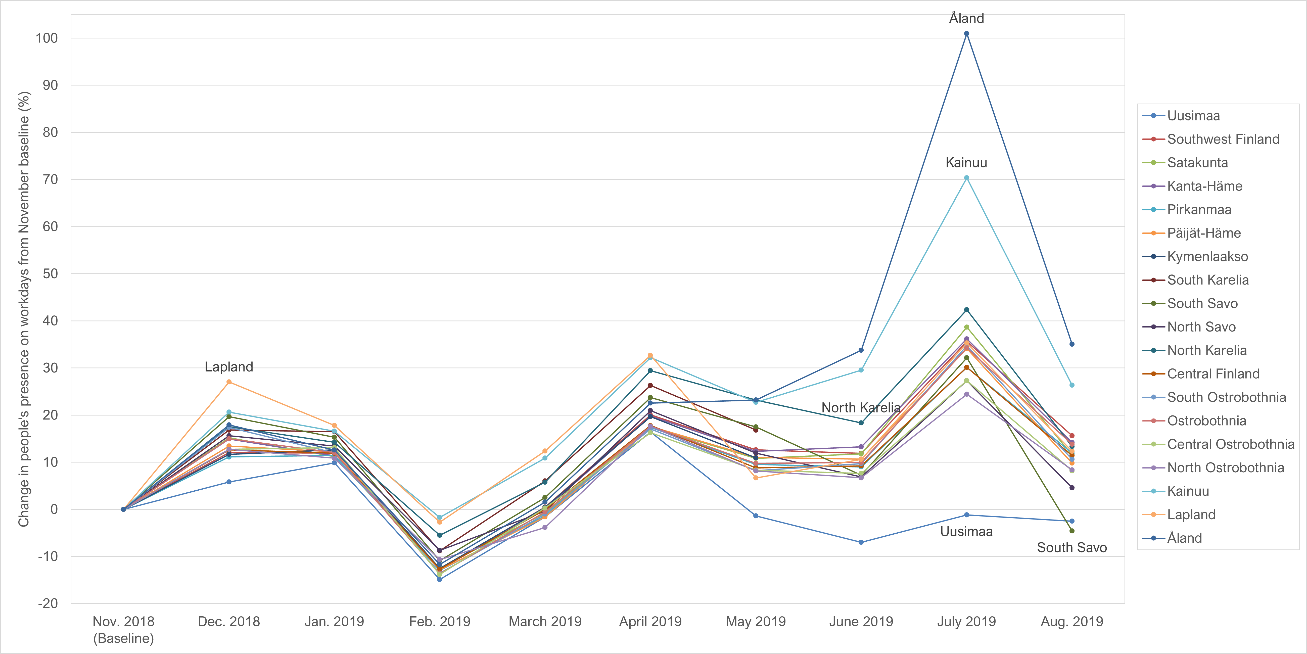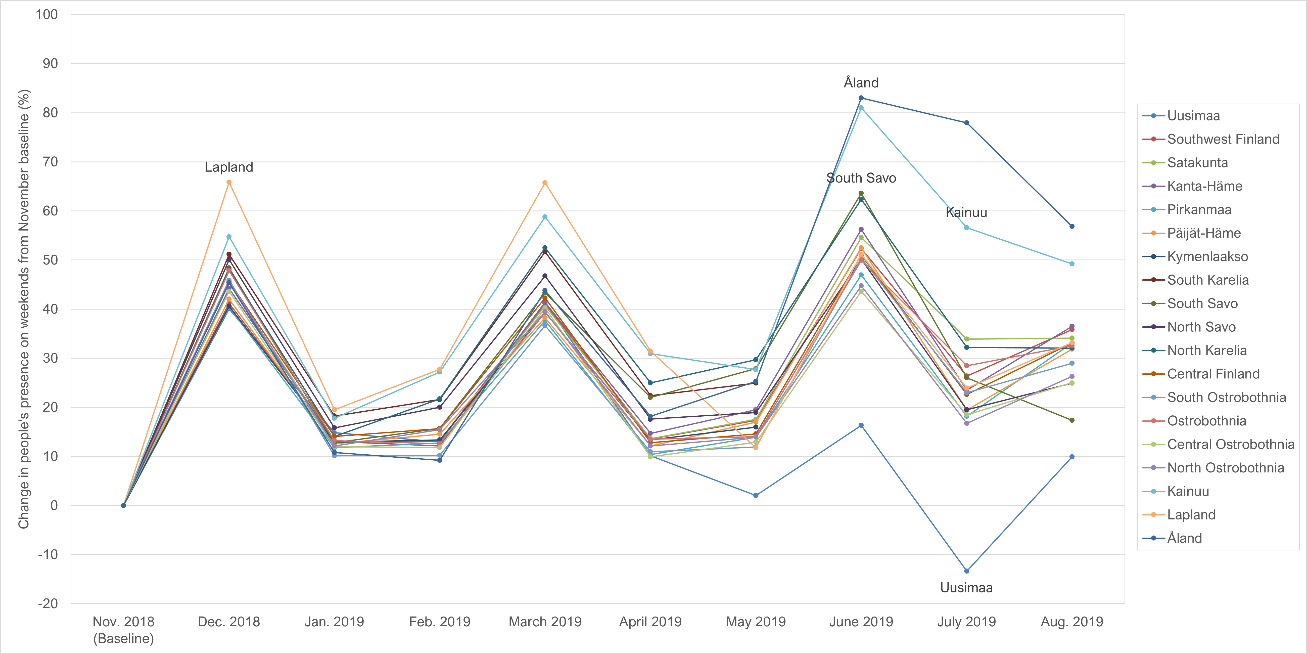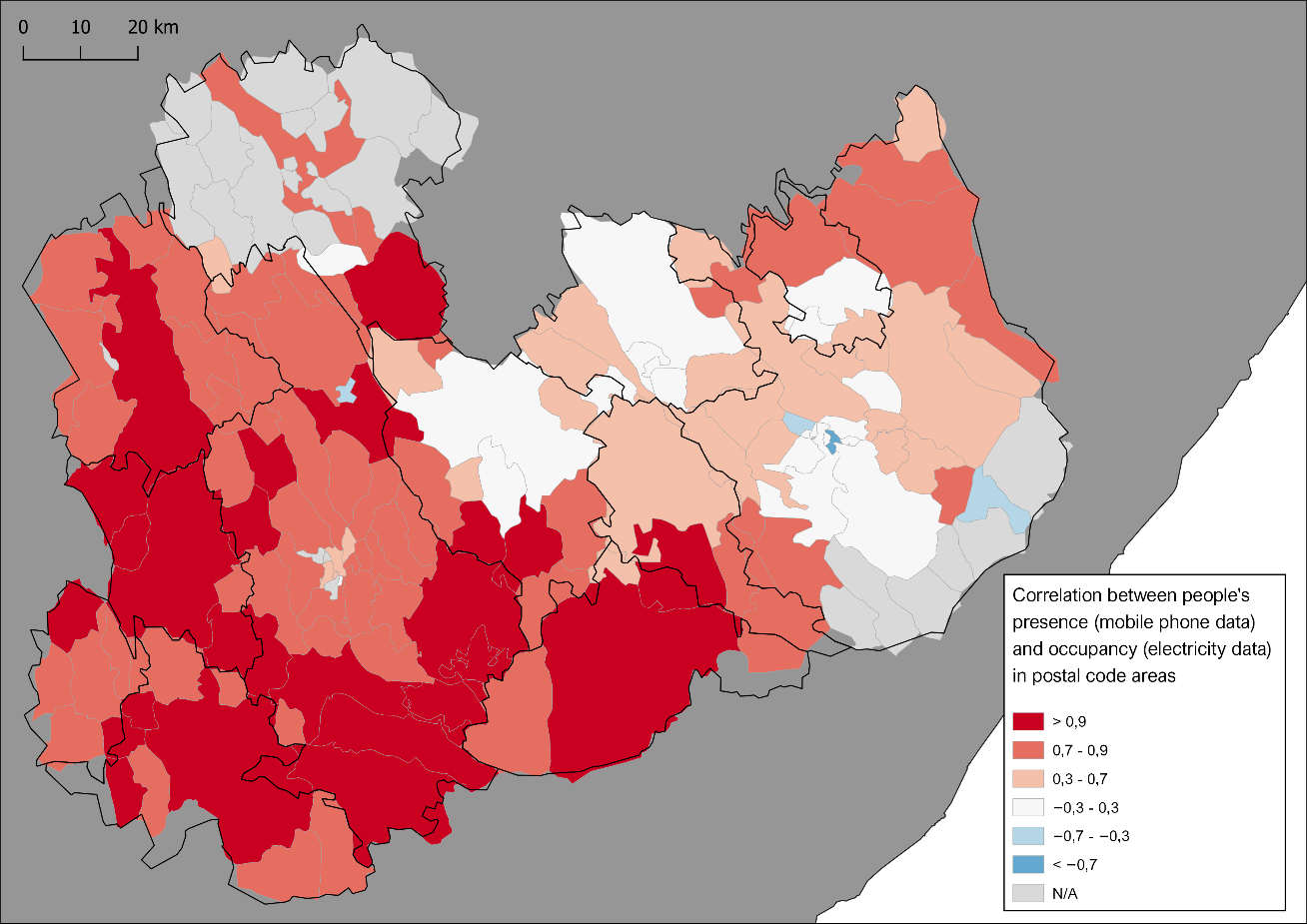Author: Iivari Laaksonen
Why is the study relevant?
Multi-local living can be defined by individuals or families having access to more than one residence in their everyday lives. It is a complex social phenomenon causing weekly and seasonal changes in population numbers as people move between regions. This means that the phenomenon is tightly connected to human mobility. In prior research, multi-locality has been mainly studied using official statistics that fail to capture the dynamic nature of people’s mobilities and dwelling. To address this in my thesis, I utilized spatially and temporally accurate big data sources − mobile phone and electricity consumption data − to capture people’s presence and mobility. More accurate information about multi-local living can be useful for local businesses and regional planning in rural areas.
How was the research done?
In my thesis, multi-local living was studied in Finland and in the county of South Savo, which has the highest proportion of second homes/free-time residences in the country. The study was done by analyzing spatiotemporal changes in people’s presence (mobile phone data from Telia Crowd Insights) and by examining how the changes relate to the number of second homes (official statistics) in different areas with correlation analyses. In addition to monthly comparisons, analyses were conducted separately for workdays and weekends to assess how people’s multi-local practices differ between weekdays. The study period of the thesis was from November 2018 to August 2019.
Mobile phone data also contains information about people’s origins (previous night location). This allowed to assess the proportions of origin counties of people visiting South Savo. Moreover, mobile phone data was used to assess the results of second home occupancy in South Savo gained from electricity consumption data which had been previously calculated in the MOPA research project.
What were the main results?
In the thesis, the analysis was first conducted at the national level comparing different counties to each other. The change in people’s presence within the study period is shown in Figure 1 for both workdays and weekends. The results indicate that people move between counties more during the summer and that mobilities vary between workdays and weekends. This can be explained by commuting patterns differing from weekend mobilities and by the timing of summer holidays. In addition to the summer months, other holiday seasons were also captured with mobile phone data. This can be seen from the high presence values in Lapland during December and during winter holidays in March.

 Figure 1. Change in people’s presence from the November baseline by county for workdays and weekends.
Figure 1. Change in people’s presence from the November baseline by county for workdays and weekends.
The monthly change of the Spearman correlation coefficient between the change in people’s presence and the number of free-time residences in Finland for workdays and weekends was also analyzed seasonally. During summer months, correlations are stronger than in the winter (Figure 2), which highlights the seasonal effect of multi-local living in Finland. Similar results about the change in people’s presence and its connection to second homes were also detected for the county of South Savo and can be found in the thesis.
 Figure 2. Change of Spearman correlation between change in people’s monthly presence from the November baseline and the number of free-time residences for workdays and weekends.
Figure 2. Change of Spearman correlation between change in people’s monthly presence from the November baseline and the number of free-time residences for workdays and weekends.
Furthermore, mobile phone data allowed calculating the proportions of origin counties of people visiting South Savo for workdays and weekends (Figure 3). The results from the baseline month of November 2018 show that a higher proportion of people who are not local (from South Savo) tend to visit the county during weekends. Also, people from counties close to South Savo to the west and south tend to visit more than, e.g., people from North Karelia which borders the county from the east.

 Figure 3. Proportions of origin counties of people in South Savo during the baseline month (November) for workdays and weekends.
Figure 3. Proportions of origin counties of people in South Savo during the baseline month (November) for workdays and weekends.
The postal code areas in South Savo were clustered based on the change in people’s presence which resulted in three types of clusters: areas with an extreme peak in presence during the summer, areas with a high peak in presence during the summer, and areas with no distinct peak in presence. The results are shown below in Figure 4 for workdays and weekends. Most of the high summer presence areas were in the west and south of South Savo in the Mikkeli subregion. However, some tourist “hotspots” were also captured in the eastern parts of the county (for instance, Järvisydän resort in north-eastern South Savo).

 Figure 4. Postal code areas by cluster type based on the change of people’s presence from the baseline for workdays and weekends.
Figure 4. Postal code areas by cluster type based on the change of people’s presence from the baseline for workdays and weekends.
Finally, the comparison of electricity consumption data and mobile phone data in South Savo revealed that, from a temporal perspective, the two data correlated better during summer months which highlights the seasonal dynamics of people’s use of free-time residences. Also, from a spatial perspective, the correlations were strong for most postal code areas, which is shown in Figure 5. The results indicate good suitability of electricity consumption data for research on seasonal population and multi-local living.
 Figure 5. Correlation between people’s presence (derived from mobile phone data) and occupancy (derived from electricity consumption data) by postal code area in South Savo.
Figure 5. Correlation between people’s presence (derived from mobile phone data) and occupancy (derived from electricity consumption data) by postal code area in South Savo.
Take home messages and future research possibilities
The thesis gives insights into the seasonal variability of population and its connection to multi-local living in Finland overall and in South Savo in particular. The results can be beneficial, e.g., for decision-makers and local businesses in South Savo.
The study period of this thesis ranged from the end of 2018 to August 2019, so the effects of the pandemic are not included in the analysis. In future, research using mobile phone data and electricity consumption could be conducted for a longer study period combining data from pre-pandemic years together with pandemic time and post-pandemic periods. This could provide unique perspectives into multi-local living and people’s mobility in general. Also, mobile phone and electricity consumption data has the potential for more accurate temporal perspectives. Daily or even hourly temporal levels could yield valuable results.
Read the full MSc thesis here: Multi-local living: a comparison between mobile phone and electricity consumption data
– – – – –
This thesis is a part of the MOPA research project. The project is carried out by the Ruralia Institute in collaboration with the Digital Geography Lab by employing electricity consumption data from Suur-Savon Sähkö Oy. The research project aims to provide accurate information about the dynamics of multi-local living for the benefit of local businesses and stakeholders in South Savo. The thesis was supervised by Janika Raun, Olle Järv and Tuuli Toivonen from the Digital Geography Lab, University of Helsinki. The Digital Geography Lab is an interdisciplinary research team focusing on spatial Big Data analytics for fair and sustainable societies.

One Reply to “MSc thesis on studying multi-local living in Finland using mobile phone data and electricity consumption data”
Comments are closed.